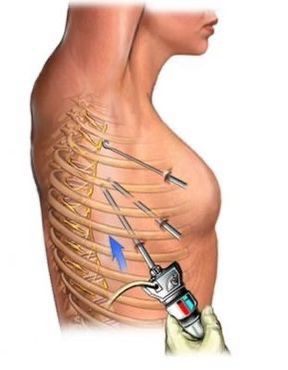Thoracic Endometriosis: When Endometriosis Affects the Lungs

When people hear “endometriosis,” they often think of pelvic pain, painful periods, and fertility issues. What’s less commonly known — and often overlooked — is that endometriosis can occur outside the pelvic region, affecting other parts of the body. One of the rarest and most mysterious forms is Thoracic Endometriosis, where endometrial-like tissue grows in the chest cavity, particularly around the lungs and diaphragm.
Despite being rare, thoracic endometriosis can cause life-threatening complications and is often misdiagnosed. This post dives deep into what thoracic endometriosis is, how it presents, and how women can better understand and advocate for themselves.
What Is Thoracic Endometriosis?
Thoracic Endometriosis Syndrome (TES) is a rare manifestation of endometriosis where endometrial tissue is found in the thoracic (chest) cavity, typically involving the:
Lungs (pulmonary parenchyma)
Pleura (lining of the lungs)
Diaphragm (the muscle separating the chest from the abdomen)
This misplaced tissue still responds to hormonal changes during the menstrual cycle. As a result, women may experience chest-related symptoms that cycle monthly, often peaking just before or during menstruation.
Symptoms of Thoracic Endometriosis
The symptoms of thoracic endometriosis can mimic other conditions and may seem unrelated to the reproductive system, making diagnosis difficult. Common symptoms include:
1. Catamenial Pneumothorax
Spontaneous lung collapse during or around menstruation — the most common symptom of thoracic endometriosis. Affected women may feel:
Sudden chest pain (often on the right side)
Difficulty breathing or shortness of breath
Coughing
2. Catamenial Hemothorax
Bleeding into the chest cavity that occurs cyclically with menstruation. Symptoms may include:
Chest or shoulder pain
Coughing up blood (hemoptysis)
Fatigue or dizziness
3. Catamenial Hemoptysis
Coughing up blood during menstruation due to endometrial tissue in the lungs. This is less common but very alarming.
4. Diaphragmatic Endometriosis
Pain in the upper abdomen, ribs, or shoulders — especially on the right side — which worsens around menstruation.
Who Is at Risk?
Thoracic endometriosis most commonly affects women between the ages of 20 and 40, especially those with a known history of pelvic endometriosis. However, many women with thoracic involvement may not have been previously diagnosed.
While it is rare, the actual numbers may be underreported due to lack of awareness and frequent misdiagnosis as:
Asthma
Tuberculosis
Lung infections
Pleurisy or pneumonia
This is especially critical in Nigeria and other countries where TB is endemic, and symptoms like coughing up blood are automatically assumed to be tuberculosis-related.
How Does Endometrial Tissue Reach the Chest?
Several theories attempt to explain this, including:
1. Transdiaphragmatic Passage
Endometrial cells travel from the pelvic cavity to the thoracic cavity through small holes or defects in the diaphragm.
2. Lymphatic or Blood Spread
The cells may spread through lymphatic vessels or blood circulation.
3. Coelomic Metaplasia
Cells in the thoracic cavity transform into endometrial-like tissue under hormonal influence.
Diagnosis: How Is Thoracic Endometriosis Confirmed?
Diagnosing thoracic endometriosis can be challenging. A thorough medical history and a high index of suspicion are essential, especially if the patient presents with cyclical chest pain, coughing, or lung collapse.
Diagnostic tools include:
Chest X-ray or CT scan (to detect pneumothorax or hemothorax)
MRI (to assess diaphragmatic lesions)
Video-assisted thoracoscopic surgery (VATS) – the most definitive way to confirm diagnosis, where tissue can be seen and biopsied directly.
Hormonal history correlation – identifying that symptoms occur in line with the menstrual cycle.
Treatment Options
There is no universal cure for thoracic endometriosis, but treatment typically aims to manage symptoms and prevent recurrence. Approaches may include:
1. Hormonal Therapy
Birth control pills
Gonadotropin-releasing hormone (GnRH) agonists
Progestins
These treatments suppress ovulation and reduce estrogen levels, helping to stop the growth and shedding of endometrial-like tissue.
2. Surgical Management
VATS to remove ectopic tissue and seal holes in the diaphragm
Resection of lung nodules or diaphragm repairs
Surgery may be combined with hormonal therapy for better outcomes.
3. Lifestyle and Nutritional Support
While medical and surgical treatment is primary, supportive care through nutrition can help manage inflammation, reduce pain, and improve energy.
Nutrition and Thoracic Endometriosis
A nutrient-rich, anti-inflammatory diet is beneficial for women with any form of endometriosis, including thoracic. It helps reduce overall inflammation and may lessen the severity of symptoms.
Anti-inflammatory foods:
Leafy greens (ugu, waterleaf, bitter leaf)
Fruits rich in antioxidants (pineapple, pawpaw, watermelon)
Omega-3 fatty acids (Titus fish, flaxseed, walnuts)
Whole grains (millet, fonio, guinea corn)
Ginger and turmeric – natural anti-inflammatory spices
Water and fiber-rich foods to support digestion and hormone elimination
Foods to limit:
Red and processed meats
Dairy (for some individuals)
Refined carbs and sugars
Deep-fried or processed foods
Caffeine and alcohol
Also important: adequate vitamin D, magnesium, and iron intake — especially if heavy bleeding or fatigue is a concern.
The Emotional Toll of a Misunderstood Condition
Living with thoracic endometriosis can feel isolating. The unpredictability of symptoms, fear of lung collapse, and lack of understanding by healthcare providers can lead to anxiety, depression, and emotional exhaustion.
This is why creating safe spaces, support groups, and accessible education platforms like TGNC is critical — to help women feel seen, heard, and supported.
Final Thoughts: Raise Awareness, Save Lives
Thoracic endometriosis is rare — but it’s real. Women should not be told their symptoms are “in their heads” or “just stress.” If you or someone you know experiences unexplained chest symptoms around menstruation, speak up. Advocate for further tests. Insist on being listened to.
Healthcare providers also need more education on this rare but impactful condition, so diagnosis is not delayed by years.
TGNC Is Here for You
We’re passionate about women’s health, education, and empowerment. From pelvic to thoracic endometriosis, we believe in helping women understand their bodies and supporting professionals who care for them.
Follow us for more blog posts, educational materials, and community-driven support tools.

